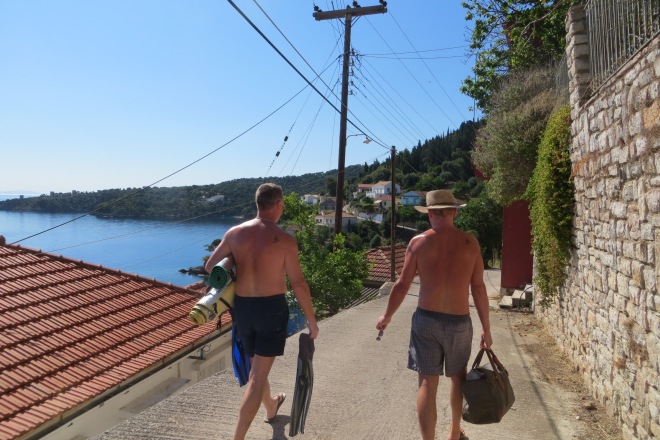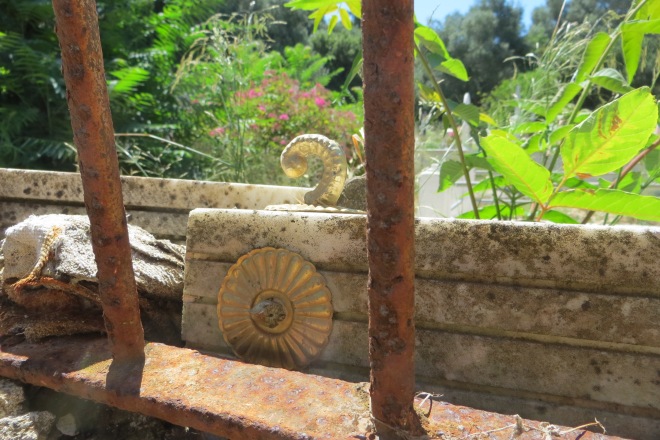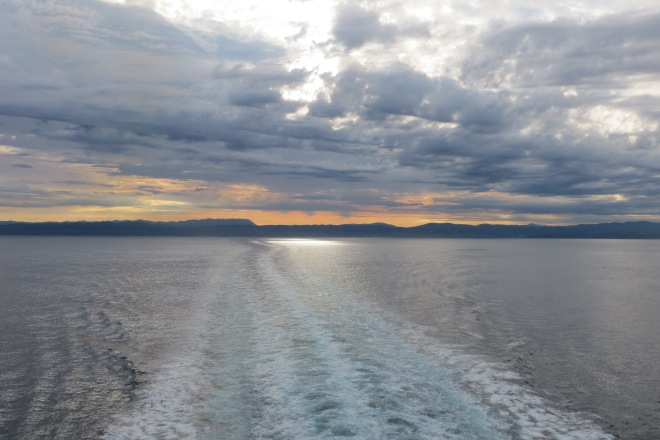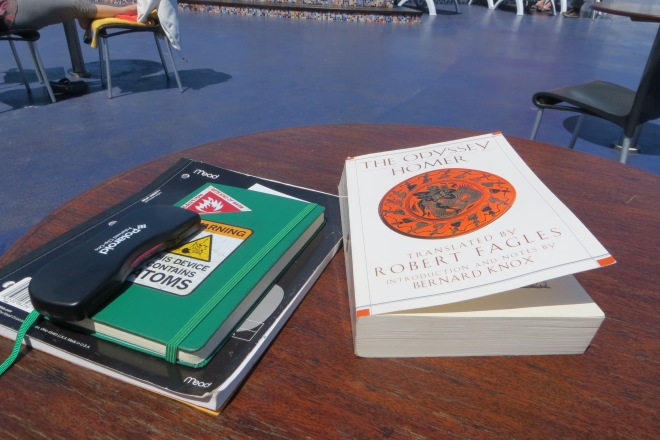Ithaca … yes, I seem to have heard of Ithaca,
even on Crete’s broad island across the sea,
and now I’ve reached it myself.
~~Odysseus, to Athena, in disguise
I arrived in darkness and in darkness I traveled the winding roads through the hills in a shared taxi to the small town of Kioni. I couldn’t see much, but the taxi deposited me in the driveway below my friends’ apartment just above the little town. It was, as in so many photos of Greece, white and blue in the heated darkness.
When I woke the next morning, my friends said that their life while in Kioni was sedate and fairly set: breakfast, off to the beach, back for lunch, down to town for a drink, back to the apartment for a bit, then down into town again for dinner. Would I have a problem with that, they asked.
I told them no, that sounded lovely, and I had a book, and notebooks for writing, to keep me occupied. I waved my Odyssey at them.
That was, indeed, how my days were occupied during my visit. Every morning, we got up and walked down to Cemetery Beach after having breakfast. It was about 15 minutes away, down a road and then a trail through the woods. Tall, narrow cypress trees interspersed the pines. Everywhere, at all times, there was the chirring sound of crickets under everything else. They were nearly loud enough that I thought them cicadas. They were also, as I discovered later, damned near the size of mice. Geraniums were quite literally bushes there, much larger than I’d ever seen before.
The eponymous cemetery was behind a wall, across the road from the beach, shielded by trees and weeds and vines. Up on a little bank above the beach proper, was a bar. It was separated from the cemetery by thin, brown reed walls. The bar was set up in a little kitchen trailer, with a cooler nearby, and a reed roof over the seating area, under oaks with tiny leaves. I think the oaks were Quercus coccifera, also called the Kermes Oak– an evergreen species with tiny, holly-like leaves. The ground beneath the trees was sparsely sprinkled with tiny, immature acorn caps, and the occasional larger, empty cap. I didn’t see any of the actual acorns. The bar served coffee, sodas, beer and other alcoholic beverages, light snacks, and apparently some evenings they were also open for dinner, but requested reservations.
Each day, I’d have a swim, then a Greek coffee with a glass of water, then another swim, before we’d head back. Stephen and Peter would go snorkeling, looking for sea urchin shells. They asked if I’d like to snorkel, but my eyesight is so bad I’d need a prescription mask in order to see anything. I love snorkeling and, back when I was in the Navy and living in Hawaii, I actually qualified as a SCUBA diver, but those days are long behind me. The water in the Salish Sea is far too cold for me, and you really rather need a dry suit to tackle it, so I haven’t dived or snorkeled since 1980. Now that I’m living on warmer water, though, I’m considering taking up snorkeling again, once I can find a proper mask that will allow me to actually see.
One day, I found myself needing to use the restroom. There is one behind the bar, walled in with reeds, just like the bar itself. I was expecting perhaps a porta-potty. What I got was a bit surreal. There, sitting under the open sky, on the white gravel of the earth, was a fully plumbed and functional ceramic toilet. It was such a surprise in that setting that if I’d had my camera with me instead of leaving it in my bag, I’d have taken a photo.
Each afternoon, after lunch, Peter and I would go down to Kioni (Stephen had other things he needed to do) and have a glass of wine, passing the time at Café Spavento. Chairs and tiny tables line the narrow crossroads outside, with barely room for cars to pass. The place is run by Jennie, a British woman who’s been in Kioni for many years. She helped me get a bus ticket back from Kyllini to Patras, calling down to the Pisaetos ferry dock and arranging things for me. She was really friendly and very kind.
Unfortunately, this little slice of paradise has its own politics and its share of small-town bullshit going on, just like everywhere else. Two years ago, a man from the town of Vathi (the largest town on Ithaki) came to Kioni and opened a restaurant. When he arrived, he announced that within five years he intended to drive all the other restaurants and bars in town out of business. To that end, very recently he’s managed to have people associated with Spavento arrested four times for having their chairs and tables along the street side. The tables have been there for years, with appropriate payments to the town council for a waiver of the law against such things. The owners of the other restaurants are also being harassed and arrested. Apparently, even the cops in Kioni are sick of it. The whole thing is ridiculous, and one of the cops even suggested to the people at Spavento that they hire someone to get arrested in their place when things like this happen. Apparently, that’s a thing. At any rate, the guy who wants to put half the town out of business runs a place called Mills, so if you do end up in Kioni, for the sake of all the other small businesses in town that are employing quite a few people, don’t eat there.
Every afternoon, like clockwork, two boatloads of tourists land at the end of the waterfront in Kioni and swamp the place for about 45 minutes. It was always an eclectic mix, but there was inevitably at least one guy in an ill-advised Speedo and nothing else wandering around town. I get that it’s hot, and I’m down with wearing what you like to the beach, and naturisim for people who are into nudity, but really? The center of a small town isn’t actually a beach, and it seemed rather inappropriate. Even just a pair of shorts or a towel around the waist would have been nice.
Late afternoons back at the apartment were spiced with the amplified hawking of a couple of guys with pickup trucks. One of them was selling plastic tables and chairs, the other selling fruit and vegetables. Their rhythmic calls never varied, echoing against the hills behind Kioni as they drove slowly along. It felt kind of like ice-cream trucks, but rather more practical, and less likely to drive anyone mad with tinny canned music on a short loop.
The view from the balcony of the apartment is amazing. There were always swallows swooping around and lighting on the wires outside. The hills and the beaches, the sailboats, and the colors, all seemed like something out of a dream. There were moments when I felt like I was living in a travel poster. Of course, at that point, I rather was. My hosts told me that, during the winter, Kioni has a permanent population of about 80 people. Most ferry service is sparse, and people don’t come on holiday because the sea is treacherous and the weather unpredictable.
Dinner every night was at the Mythos restaurant. The restaurants down in Kioni are all on the waterfront, with covered tables right at the water’s edge. There’s a significant stray cat population that converges on them during meal hours, though they are far more polite than any of the pigeons. The cats wait patiently near the tables, hoping for a handout or a dropped bit. There’s a spay and neuter program in the area, but they do also help keep the rat population down. The food at Mythos was excellent. Everything I had there was great, and the octopus appetizer was the best octopus I have ever had in my life: tender, juicy, perfectly seasoned. That stuff was tentacle sex on a plate, and I mean that in the best possible way.
I finished my reading of The Odyssey on my last full day in Kioni. My hosts had arranged for a cab to come pick me up at about 6:30 the next morning to get back to Pisaetos in time for the ferry. I bid them a fond farewell before we all went to bed that night.
At the ferry dock, I went to the kiosk as advised, and picked up a bus ticket there, so thank you, Jennie, for all your help. The bus boarded the ferry at Poros on the way back to Kyllini; I put my bag in the cargo hold at that time, and boarded the bus when it debarked on the mainland. That had to be the strangest bus stop ever, waiting on the ferry deck with other people catching the same one. Several buses boarded, so I had to figure out which was the one I needed. One was headed for Athens, others to different destinations. The Patras bus was clearly marked with a little cardboard sign in the windshield. I think it was the same one I’d ridden in on, with a little Greek Orthodox icon in the driver’s side window. The driver played local music rather than the English-language pop I hear everywhere else. I really enjoyed listening to it, as a very refreshing break from the pop. A kid who might have been his son rode in a jump seat in front of the door once everyone boarded. He’d been helping with the baggage.
When I got back to Patras, I needed to get some ouzo for my brother. I’d thought about going into town for it, but ended up getting a taxi down to the ferry terminal for Italian-bound boats. This was in a different part of town than the arrival docks, so I was glad that I’d caught a cab instead of walking up to where I’d arrived, as I’d considered doing. They did have a fair-sized duty-free shop, so I got him a bottle there, and grabbed some lunch. I was also able to upgrade my ticket to a bed in a four-person cabin, as the trip involved a full night and an arrival scheduled for about 1:30 in the morning back in Trieste. It cost an extra €38 but was, I thought, worth every penny. Said cabin included a toilet and shower and, because the route back to Italy was nearly deserted, I ended up having the cabin to myself.
Our afternoon was hot and sunny, but as they day proceeded toward evening, clouds rolled in. Most of the trip was cooler, windier, and darker than the trip in. I was pretty exhausted, so I spent some time in my cabin writing, but was dealing with a growing migraine. I took what medications I had available, but still ended up getting sick, so the private bathroom was a relief. I was so glad I didn’t have to run for one of the public bathrooms on a different deck and puke in a stall. Being able to sleep in absolute darkness after that, alone, in the quiet, was a blessing.
After Ancona, we did hit the storm, and passed through it. The boat rocked and rolled its way through the final Brazil-Germany game of the World Cup, announced in Greek. Later that evening, it was “The Tudors” in Italian. Because of the heavy seas, we arrived over an hour late back in Trieste, just on the edge of the storm. I was out on deck for part of our arrival, watching the harbor lights, and the great, blinking beam of the Faro Vittora, lightning painting the sky and lighting the clouds around us. The rain hit just as the foot passengers were debarking, and my brother had been waiting, hoping vainly that we’d be ashore before the storm arrived. We ended up riding his motorcycle back to my place in the pouring rain, soaked to the skin. I unpacked my bags; fortunately my book and notebooks hadn’t been damaged, though things were a bit damp. Home at last, a hot shower and bed called my name.





















